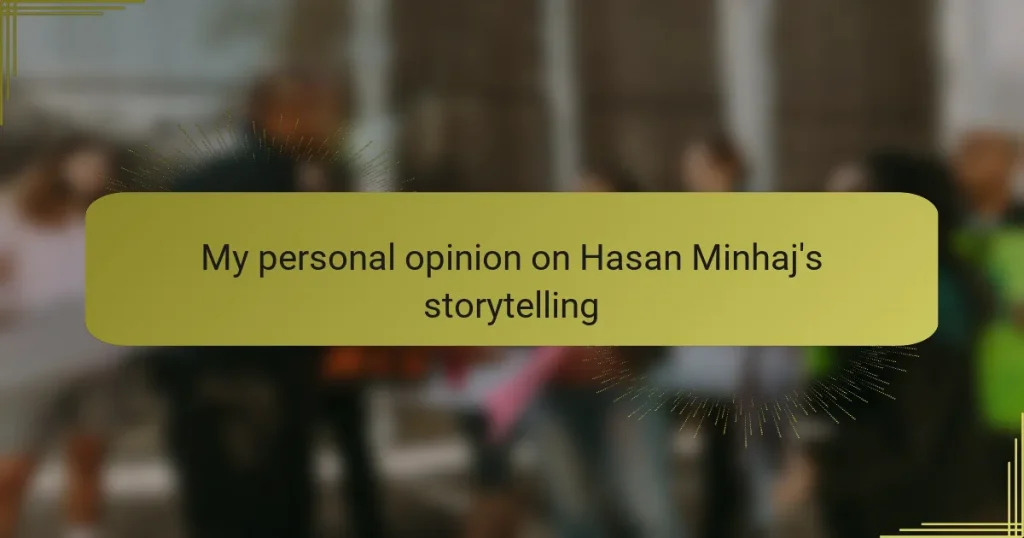Key takeaways
- Political satire awards celebrate humor that critiques current events, promoting essential conversations about democracy.
- Effective storytelling in satire simplifies complex issues, engages emotions, and fosters community connections.
- Hasan Minhaj’s unique style combines personal anecdotes and cultural insights, encouraging reflection and sparking meaningful discussions.
- Key elements of effective satire include timing, relatability, and absurdity, which enhance the impact of social critique.
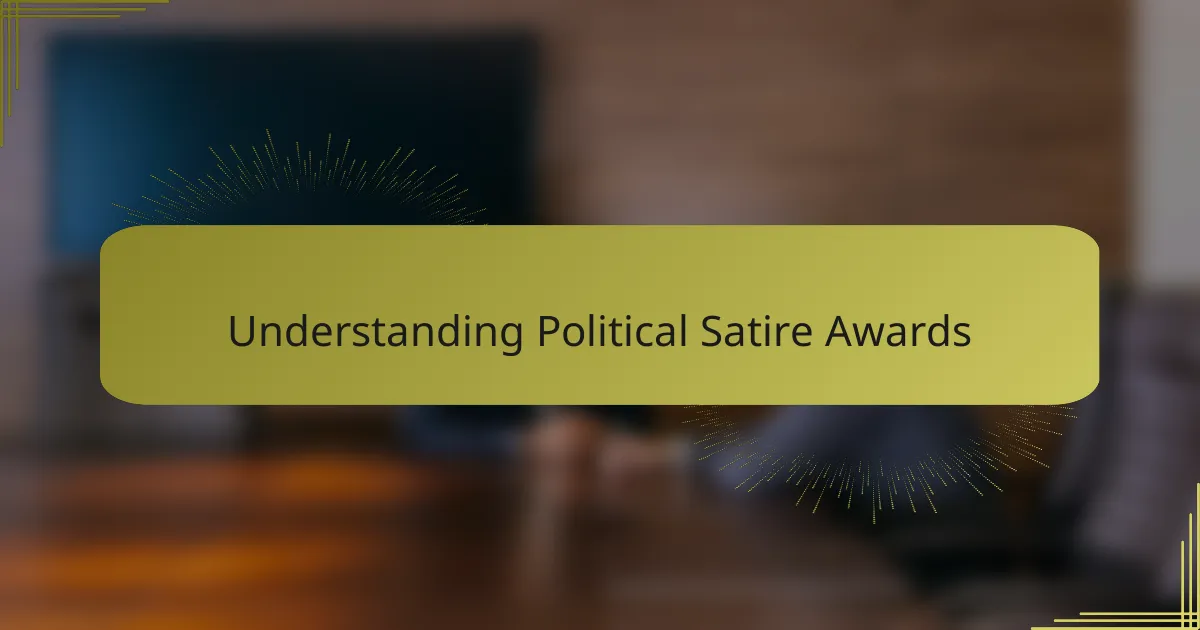
Understanding political satire awards
Political satire awards hold a special place in the realm of entertainment and social commentary. They celebrate those who artfully blend humor with critique, often providing a refreshing lens on current events. It’s fascinating to consider how satire not only entertains but also informs—don’t you think that laughter can sometimes lead us to deeper understanding?
I remember the first time I watched a satirical piece that really struck a chord with me. It was a moment of clarity disguised as humor, pulling the curtain back on the absurdities of politics. These awards recognize storytellers like Hasan Minhaj, who excel in this art, creating narratives that resonate long after the laughter fades.
Moreover, these awards serve as a reminder of satire’s powerful role in democracy. They encourage comedians to take risks and push boundaries, sparking essential conversations. Isn’t it interesting how important topics can be addressed through the lens of comedy, allowing us to digest complex issues more easily? Ultimately, the significance of these awards goes beyond trophies; they signify a commitment to truth wrapped in wit.
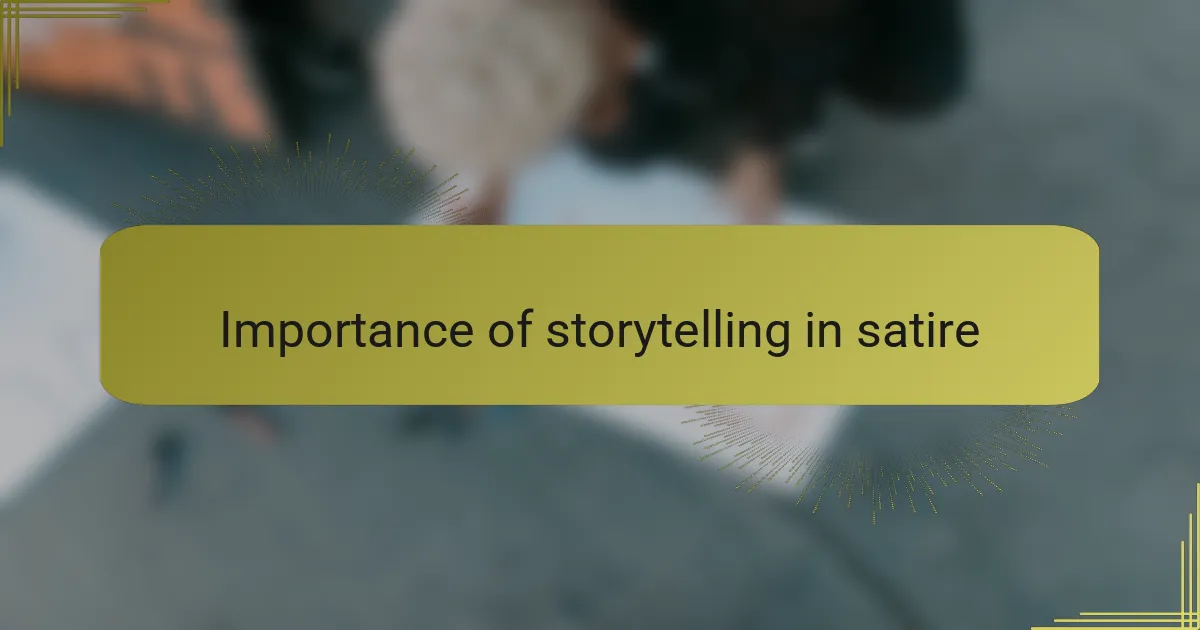
Importance of storytelling in satire
Storytelling is the backbone of satire, transforming complex political issues into relatable narratives. I’ve always believed that a well-told story not only entertains but also educates the audience about nuanced topics. For instance, when I watched Hasan Minhaj blend personal anecdotes with broader societal critiques, I was struck by how his storytelling made me reflect on my own experiences and perspectives.
Through these narratives, satire becomes a vehicle for empathy, allowing us to connect with characters and scenarios that might otherwise seem distant. This connection is crucial for sparking conversations and provoking thought. Here are some key aspects of storytelling in satire:
- Engages the audience emotionally, making them more receptive to the message.
- Simplifies complex political issues, so they become accessible and relatable.
- Encourages critical thinking by challenging prevailing narratives through personal examples.
- Creates a shared experience, fostering community among viewers with diverse backgrounds.
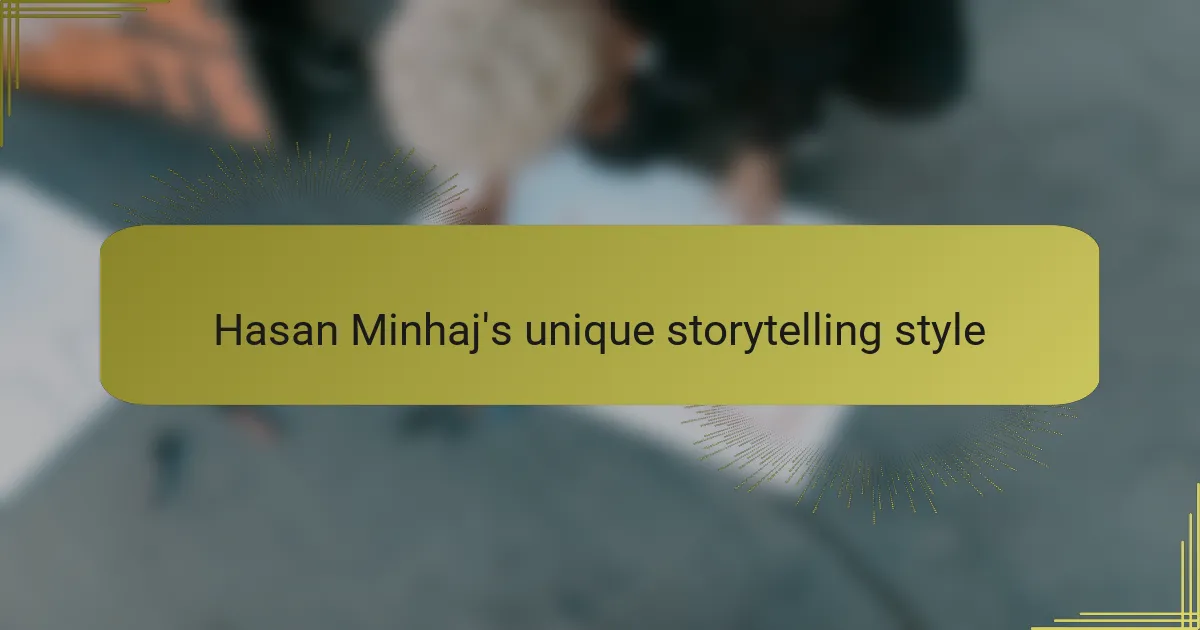
Hasan Minhaj’s unique storytelling style
Hasan Minhaj’s storytelling style captivates audiences through its blend of humor, cultural insight, and heartfelt sincerity. I remember watching his special “Homecoming King,” where he seamlessly weaves personal experiences—like his immigrant family’s struggles—into broader social commentary. This approach not only makes his stories relatable but also encourages viewers to reflect on their own narratives.
What stands out to me about Minhaj is his masterful use of visuals and pacing. He often combines vibrant graphics with an energetic delivery, which keeps the audience engaged while emphasizing his key points. It’s a refreshing take on traditional storytelling, making complex topics more accessible and enjoyable.
- Engages the audience with relatable, personal anecdotes.
- Uses humor to address serious social and political issues.
- Incorporates visuals that enhance storytelling and illustrate key themes.
- Balances emotional depth with lighter moments, creating a powerful connection.
- Innovatively blends cultural identity with universal themes of struggle and triumph.
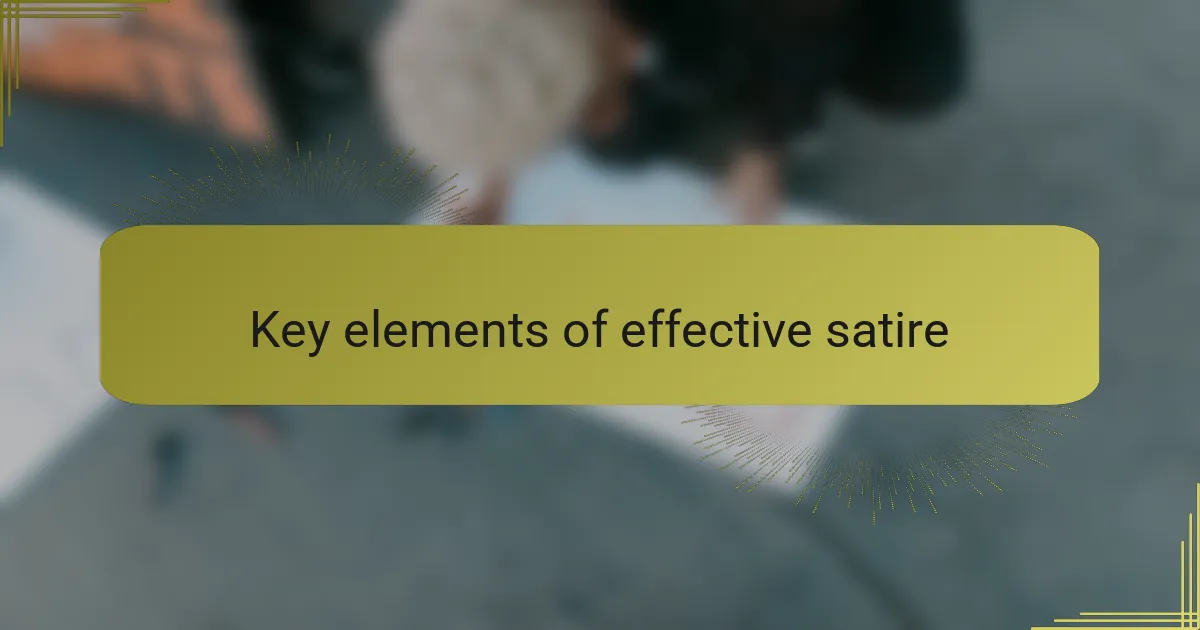
Key elements of effective satire
When we think about effective satire, one key element that stands out is timing. Timing can make or break a comedic punchline, and it’s crucial for delivering commentary on sensitive topics. I often find myself laughing hard at a well-placed joke that reveals a larger truth; it’s almost as if the humor creates a safe space for hard conversations. Isn’t it interesting how the right timing can turn a casual giggle into a moment of reflection?
Another vital component is relatability. Satire shines brightest when it resonates with the audience’s experiences or values. I recall laughing at a sketch that mirrored my own frustrations with bureaucratic red tape; it felt as though someone was finally voicing what I felt. When a comedian taps into shared sentiments, it fosters a deeper connection with the audience, making the critique more impactful.
Lastly, the element of absurdity is indispensable in satire. It exaggerates reality to highlight the ridiculousness of certain situations, often making us reconsider our perspectives. I remember watching a segment where a familiar political figure was portrayed in an exaggerated, comical light. That absurdity not only made me laugh but also prompted me to think critically about the implications of their actions. Wouldn’t you agree that sometimes, pushing the envelope with absurd humor is what drives the point home?
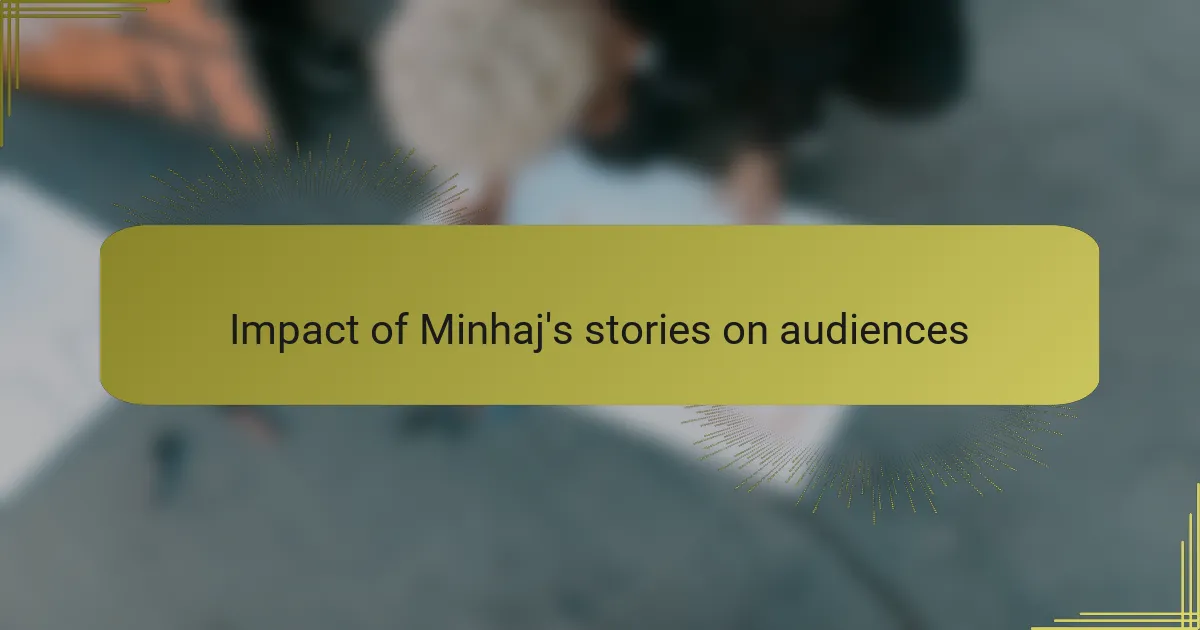
Impact of Minhaj’s stories on audiences
Hasan Minhaj’s storytelling resonates on a deep emotional level with his audiences. When I watch his performances, I often find myself laughing one moment and reflecting the next; that blend of humor and truth is powerful. His ability to weave personal anecdotes with broader social commentary makes complex political issues more relatable, striking a chord with viewers.
Minhaj’s storytelling doesn’t just entertain—it provokes thought and sparks conversation. I remember discussing his Netflix special with friends, and we all felt compelled to share our own experiences related to the topics he presented. This personal connection is what sets his work apart and enhances its impact.
Here’s a comparison of the impact of Minhaj’s stories on audiences:
| Aspects | Impact |
|---|---|
| Humor | Eases tension and encourages engagement |
| Relatable anecdotes | Connects personal experiences to broader themes |
| Provocative questions | Stimulates discussion and critical thinking |
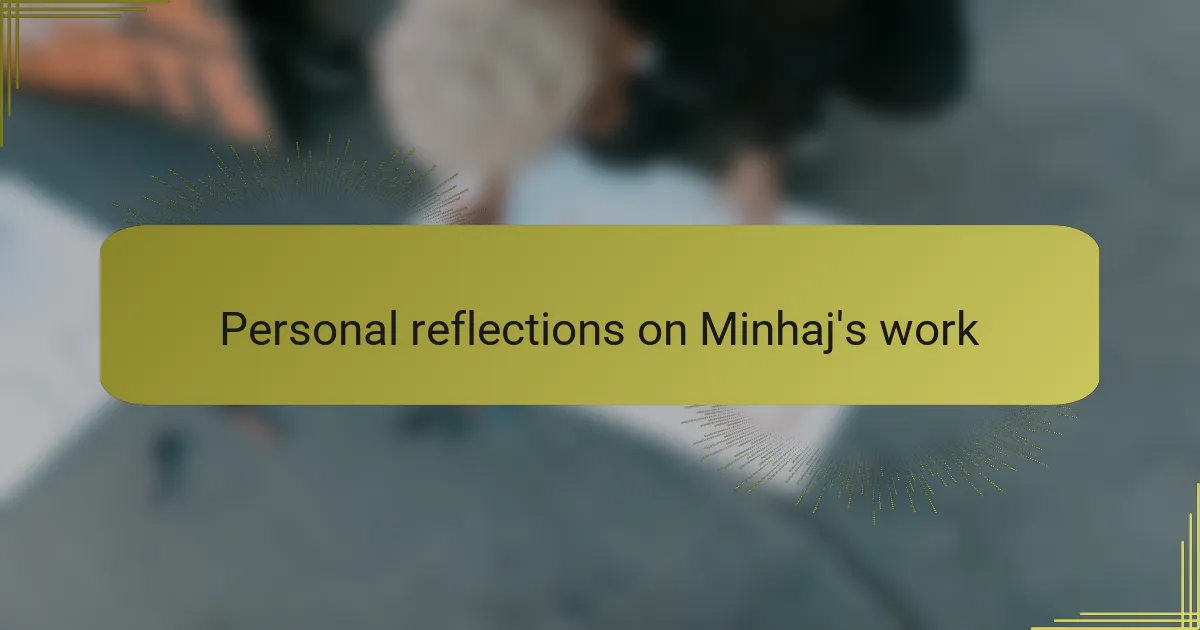
Personal reflections on Minhaj’s work
Hasan Minhaj’s storytelling resonates with me deeply, primarily because he blends humor with poignant social commentary. I remember watching his Netflix special, “Homecoming King,” and feeling a rush of recognition when he spoke about the immigrant experience. His ability to articulate the complexities of identity while making us laugh is something truly special.
In my opinion, the strength of Minhaj’s work lies in his personal anecdotes that evoke empathy and challenge societal norms. It’s not just about delivering a punchline; it’s about sparking a conversation that often feels overdue. Here are some observations I’ve made about his style:
- Minhaj uses personal stories to bridge the gap between cultures.
- His comedic timing is impeccable, making serious topics more digestible.
- He crafts narratives that empower marginalized voices.
- The emotional nuances he includes enrich the humor and prompt reflection.
- His storytelling is a reminder of the power of vulnerability in comedy.
